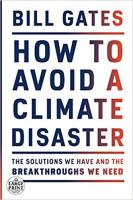
In How to Avoid a Climate Disaster, Bill Gates discusses how at this point, climate change is unavoidable; too much time was not used to solve the climate change crisis, so wildfires, rising sea levels, increased storms for some and droughts for others are inevitable now and in the future. However, the worst consequences of climate change are avoidable, just so long as every country can achieve net-zero greenhouse gas emissions. Although the world is far from net-zero emissions, Gates mentions the current technologies governments and researchers can use to significantly reduce greenhouse gas emissions. Breakthroughs, such as a means to capture carbon creating in manufacturing processes and efficient batteries capable of storing large amounts of electricity, need to be made widely available and cheap to the public.
Personally, the most compelling aspect of the book was learning about the logistics behind carbon emissions and the various solutions Gates provided to combat climate change. I felt as if in the future, I could use my occupation as a means to reduce greenhouse gas emissions and further the cause of climate change. I would recommend How to Avoid a Climate Disaster to those interested in science and climate change, particularly those who want to deal with climate change but do not understand the logistics of the problem. The book was never disappointing, as every section provided an informed perspective on various components of climate change and its solutions.
I liked the cover, because the white background and ombre color scheme for the font ensured placed the focus on climate change, not an elaborate cover design. Similarly, the cover of “How to Avoid a Climate Disaster” is reflective of its contents, entirely centered on climate change.
